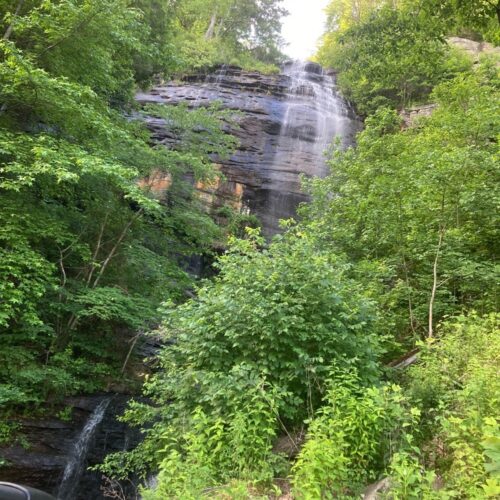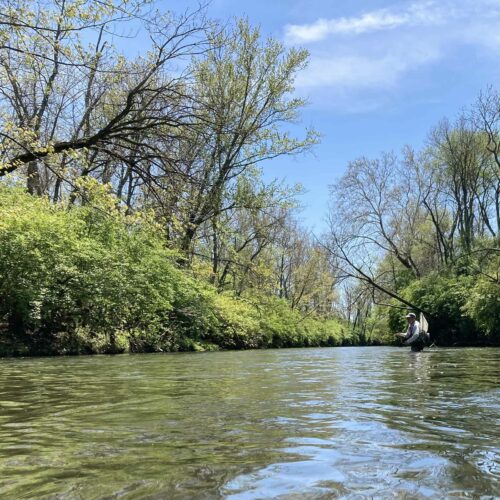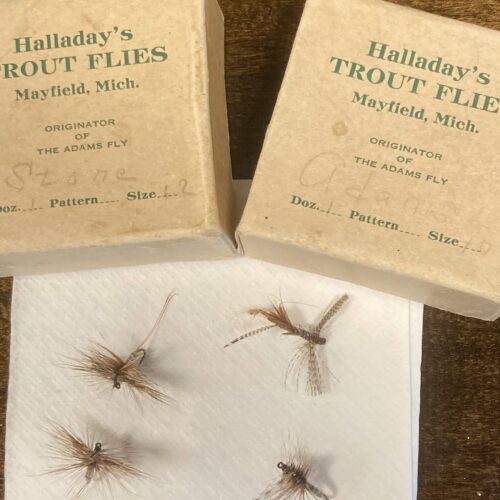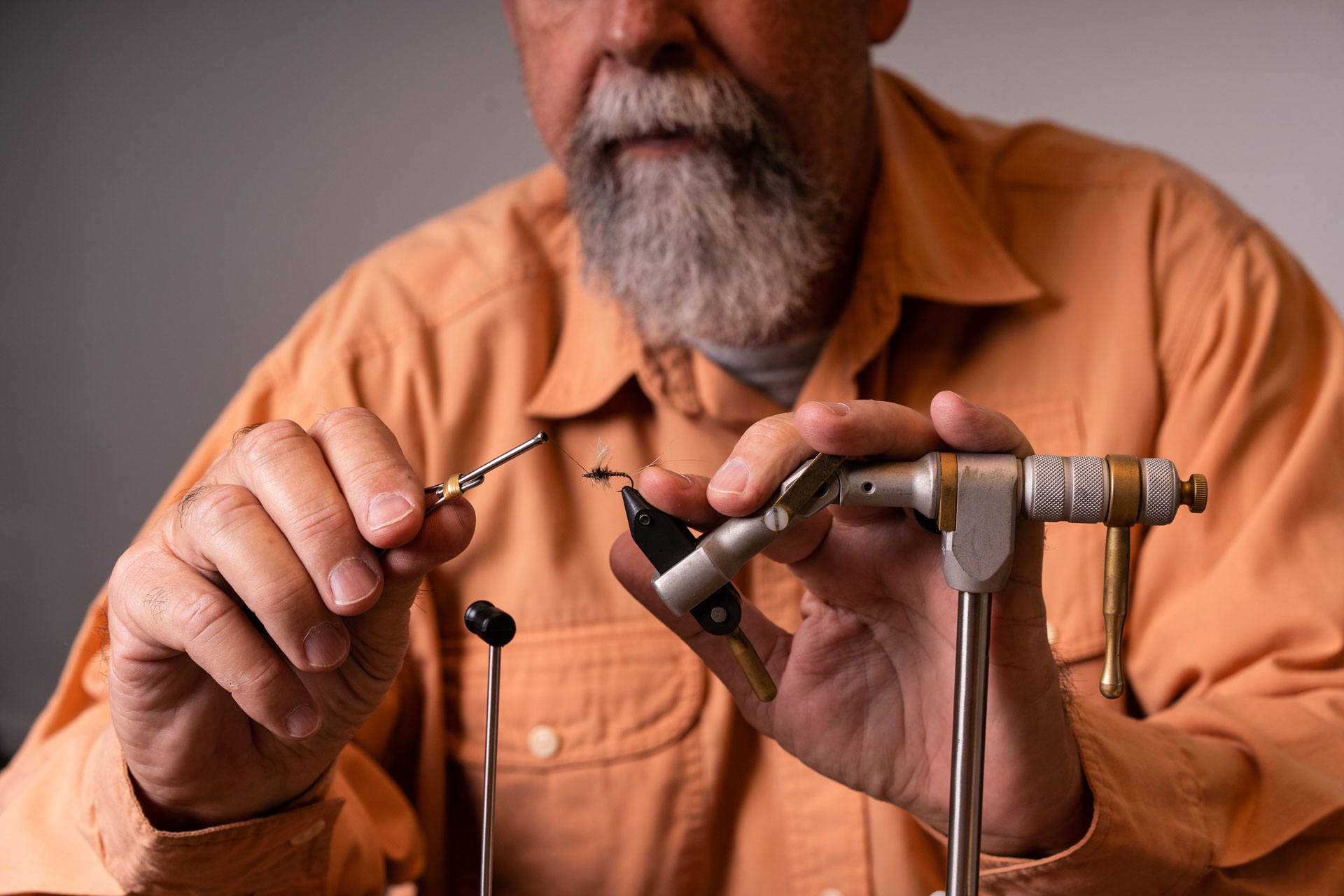
Winter is Here
Well, it is official. With the first snow on the ground here in SW Ohio, my focus has changed from fly fishing to fly tying. Oh make no mistake, there will be days spent in the River this Winter looking for trout feeding on the possible Blue Wing Olive hatches and the Midge clusters that are usually prevalent this time of the year on the Mad. However, most of my time will be spent at the tying desk either here at the Morrett Fine Art studio or at the coolest fly shop I have ever had the opportunity to shop or just hang out in, ReelFlyRod. I have had the pleasure of living in an art studio for most of my married life. I have learned much over the years by watching my fine artist wife, Melanie Morrett, make discoveries in her work that have greatly influenced my view of the world. I seem to notice small details that were previously overlooked. Colors, textures, values, movements, shades, and shadows in nature have been revealed to me over the years through the eyes and by the hands of a true artist. Incorporating these and other small details in the creation of the imitation is where the art of fly tying can be found. Being around the staff of ReelFlyRod has allowed me the opportunity to learn much from these talented young brothers of the angle in regards to modern technology. In return, I humbly feel the responsibility of connecting this team to the history and soul of fly fishing and fly tying, as best I can. Put us all in one pile and we do a pretty good job of looking back, leaning in, looking forward, and fishing as well as we can.
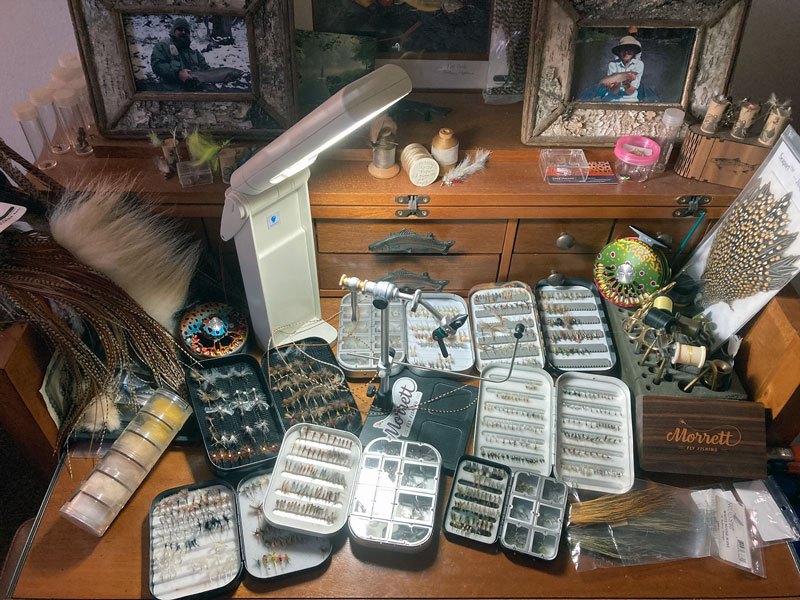
Planning Ahead
Now comes the time to reflect on successes, disappointments, and other learning experiences from this past trout season. As a fly tier, I reflect and plan for the next season beginning with my inventory boxes of flies. I maintain inventory of certain patterns of my custom flies that have proven to be successful both personally and with clients. A particular favorite Mayfly pattern will have a beginning inventory of a few dozen to start the season. Most of my patterns, in regards to custom orders, are filled to order with one remaining in my collection. With a good picture and a fly in my hand, I have found that I can pretty much re-create what I have created before. Of that I am sure, no doubt, somehow.
I usually begin my serious tying with Mayflies. I have tried and tied many different Mayfly patterns over the years and quite honestly, many have come up wanting. The Mayfly patterns I maintain in my personal inventory are made up of proven or variations of proven patterns from the Quill Gordon, the Adams, Catskill style, Vince’s Thorax Dun, the Parachute, and to the Crippled Dun. These patterns have allowed for much flexibility in regards to the multitude of different materials that can be used for the body parts of a Mayfly. Experimentation has brought me to this point and I am confident that it is still a work in progress. My Mayfly inventory boxes are organized by pattern and species. This is where I begin the tying process for the next season. I imagine the River from month to month as to what we can expect from our local waters under normal conditions.
March is the beginning of Mayfly hunting for me on the Mad River. The first pattern to be concerned with will be the Blue Quill. Sometimes in mid to late March the Blue Quills will be the first notable hatch on the Mad as well as many other Midwestern streams. I tie size 16 and 18 Adams variations to imitate the Blue Quill as well as other species found on streams throughout the year. The original Adams colors consisted of gray body, grizzly and brown tails and hackle, with Grizzly hen wings. I like to use a single Cree hackle feather for my Adams patterns instead of one brown and one grizzly. I know the fly is lighter, the Cree hackle picks up light and imitates movement like no other feather, and I just think it’s cool to use Cree. I must admit that over the years I have accumulated enough Cree cape and saddle hackle to last me a lifetime. Due to high prices and shortage of Cree in today’s market I am thinking of a small safe instead of my Cedar Box. My preferred body material varies depending on the pattern. On the original Adams pattern I use gray beaver fur. Adams parachutes call for a gray turkey biot. My Cripple and Klinkhammer Adams patterns call for Moose mane dyed gray or sometimes natural for the body. The number of flies remaining in the bin reminds me of how well the fly performed this season. I remember my largest dry fly brown trout of the season was caught on a size 16 Polar Cripple Blue Quill as documented in my Journal Entry “April Reflections”. Note to self, have plenty on hand.
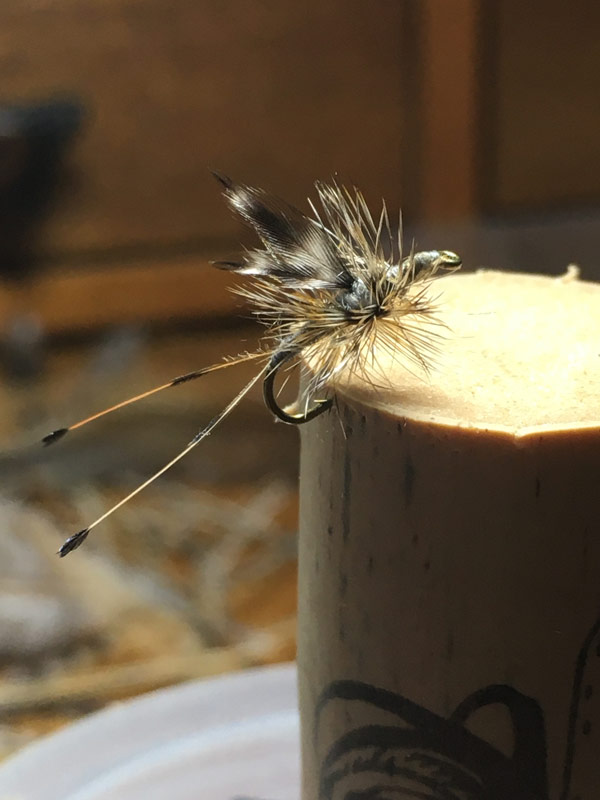
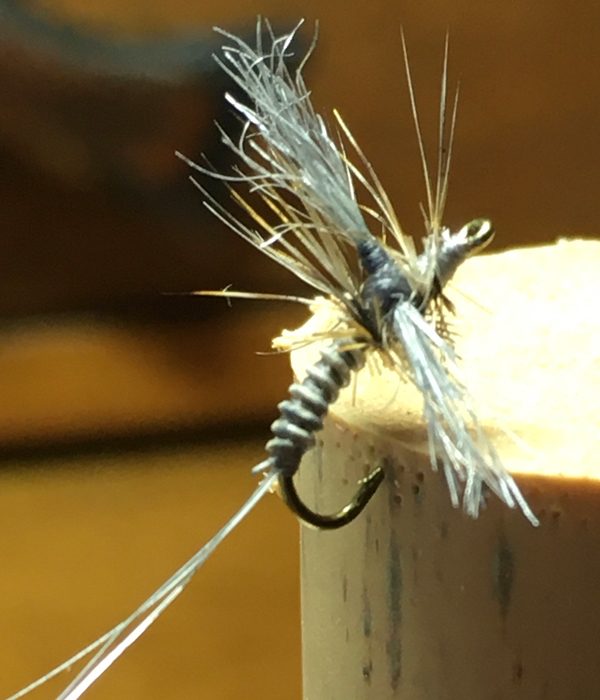
Early April could and should bring the Hendrickson hatch to the Mad River. Hendrickson patterns call for a larger beginning inventory, due to demand, with some tweaks based on this year’s results. Hendrickson Crippled Duns tied in size 16 performed better than size 14 this year. In looking back, perhaps the successes found in fooling rising trout had to do with switching to a smaller size imitation. Maybe I did not notice the smaller than usual naturals in the air during a hatch. Just something to pay attention to next Spring. I did notice, and my lack of remaining inventory confirms, that Klinkhammer emergers worked well during the Hendrickson, Sulfur, Brown Drake, and BWO hatches. One of the most satisfying and noteworthy Brown Trout of the season came right at dark on a Brown Drake Klinkhammer. I had been working the same foam line for about an hour with no luck on at least six different drake and sulfur patterns. This adventure was documented in the Journal Entry “Early Summer Dreaming”. I will need to order some Klinkhammer hooks for delivery at once. I will also need to bend some dry fly hooks for my Cripple patterns.
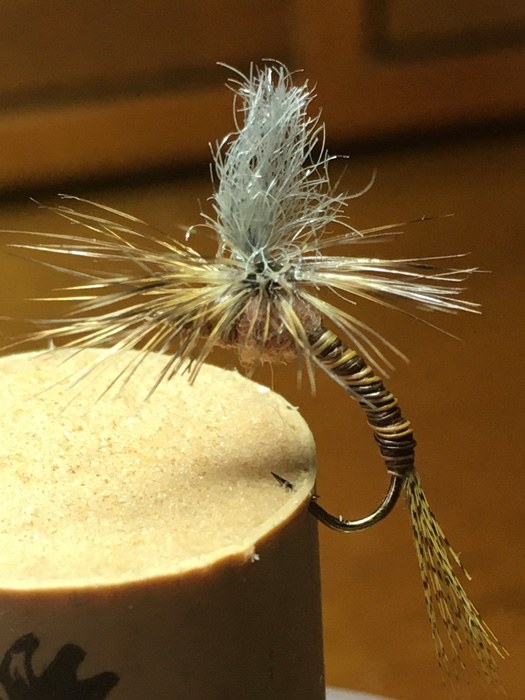
In looking at my Terrestrial box, I notice a big hole where Mattress Thrashers used to be. Once again, it seemed the smaller size pattern proved to be more successful in all the color variations I tie. During the middle of Summer the size 16 all Black Thrasher became a go to fly. I am not sure if the resident brownies thought the imitation was a cricket, beetle, stonefly, caddis, ant, or any other unfortunate flying or crawling black bug that finds itself in serious dread caught in the surface film of the stream. I guess the Thrasher in black covers a lot of bases when it comes to Terrestrials. Many risers were fooled into believing the Mattress Thrasher was whatever food source they happened to be looking up for. I need to fill the bin with size 14-18 Thrashers. In searching through some drawers, looking for something important I am sure, I came across six original Mattress Thrashers that Rusty Gates tied one rainy afternoon in his shop. One of the patterns has rubber legs that I remember Rusty said he was going to try. I am not sure if he ever got around to it. I am going to tie some up and test them out for him. I also need to talk Buck into showing me the little tweaks he has developed over the years in regards to his Deer Hair Beetle. Reality is, people come and people go. Much is to be learned and passed on while dealing with a limited shelf life. I am determined to pay closer attention to those whose opinion I respect whether tying or just living.

Putting in the Work
This is actually a great time to focus on the preparation involved with the tying of the needed patterns for next season. I have been invited by ReelFlyRod to set up a vise at the shop this Winter for myself and the other Staff tiers to share some techniques with other local tiers whether just beginning or a grizzled faced veteran. I have not been released into public to tie in a long time and I am looking forward to learning from some of our local talent. With the increased focus on fly tying comes a close look at needed materials, both personally and at the fly shop. The patterns that we tie for personal use or for our client’s use are the same patterns tied with the same materials. Any pattern we are featuring at the shop or on the MorrettFlyFishing website needs to be supported by corresponding materials available in our inventory. That is our goal. I am sure notifications will be sent out there once all the information and planning comes together. I would imagine the first of the year will be a good starting point as I have just noticed that it is mid December. We need to put together a schedule so that you will know when a tier will be at the shop and available at the vise. This is a work in progress. In the meantime, feel free to reach out if you have any questions. We will all do our best to help with the process of getting started. This includes purchasing the correct materials and tools.
Fly boxes can tell a well schooled fly fisherman much about previous fishing trips. For example, the moisture in my Caddis box teaches me a couple of noteworthy lessons from the past season. First of all, I have become complacent in regards to wading. A complete dunking in about three feet of cold November Mad River water will remind you in a hurry to be careful at all times when stepping into moving water. I also learned that water resistant phone/cameras are more of a hope, not a guarantee. After spending $500 for a new phone and a waterproof case for underwater videos that would make Jacques Cousteau jealous, I am back in the game.
One last lesson from the fly boxes that I can think of at the time of this writing. I have boxes of flies that I have tied with many patterns specific to the river or streams we were exploring. Great memories but also a little sad. I wonder if Mel and I will make it back to that special place at that special time of the year. The Little J box with the slightly orange sulfurs and the BWO cripples that were so effective on neighboring Spruce Creek in May. The small box with the White Mayfly patterns and Hex spinners on the ready for a humid August evening on the Yellow Breeches. I have a box full of beautiful large Brown Drake and Hex patterns that did the trick on an early July evening on the big waters of the AuSable below Mio. The Wheatley box with the Gray Drake patterns inspired by Matt Supinski for the Muskegon. Another small box of Sulfur Mayfly patterns tied with CDC wings and a beautiful Amber biot body takes me to mild Summer evenings slowly drifting the South Holston casting to rising brown trout. One more box of wild looking terrestrials and caddis patterns that was last opened somewhere in the Driftless Region of SW Wisconsin in early September.
I believe we could use a road trip. My problem comes from deciding between proven locations or scouting out new waters. Either way, the Mad will probably be my next adventure and flies need to be tied with that in mind. Join us at the Shop once we get going and let me know if you need some patterns in preparing for Spring. I hope to see you on the River or in the Shop in 2022 if not before.
Keep your boots on the gravel,
Greg Morrett

